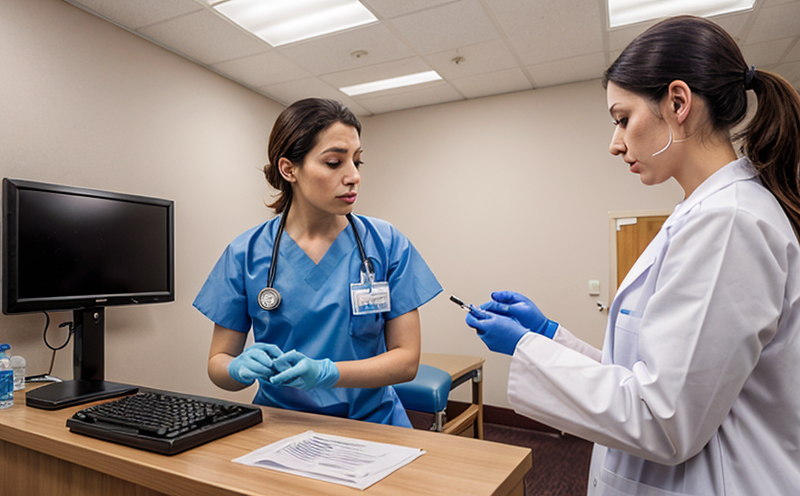Mercury Residue Testing in Fish Products
In the realm of clinical and healthcare testing, the focus on ensuring the safety and purity of food products is paramount. Mercury residue testing in fish products is a critical component that guarantees consumer health and compliance with international standards. This test ensures that seafood sold to the public does not contain excessive levels of methylmercury or other forms of mercury which can be harmful when consumed in high quantities.
Mercury, particularly methylmercury, accumulates in aquatic ecosystems through various pathways, including industrial emissions and agricultural runoff. When consumed by fish, it bioaccumulates in their tissues over time, leading to potentially toxic concentrations that are hazardous to human health. Regulatory bodies worldwide have set maximum allowable limits for mercury content in seafood to protect public health.
The testing of mercury residues involves several steps, starting with the collection and preparation of samples from various sources such as retail markets, processing plants, or fishing grounds. Proper sample handling is crucial to ensure accurate results. Samples are then subjected to rigorous analysis using sophisticated instrumentation that can detect even trace amounts of mercury. Common analytical methods include atomic absorption spectrophotometry (AAS) and inductively coupled plasma mass spectrometry (ICP-MS).
The process starts with the collection of fish samples, which should be representative of the batch or population being tested. Samples are then frozen to prevent degradation before transportation to the laboratory for analysis. Upon arrival, the samples undergo a series of preparatory steps that may include homogenization and digestion using acids like nitric acid. These procedures ensure that all mercury compounds are released into solution for accurate measurement.
Once prepared, the samples are analyzed using sensitive analytical equipment capable of detecting trace amounts of mercury. The choice of method can vary based on the level of accuracy required and the type of mercury (methylmercury vs inorganic mercury) being targeted. Results from these analyses provide critical information about the safety of the fish products under scrutiny.
Compliance with international standards such as ISO 17025 for laboratory accreditation, along with adherence to specific testing protocols like those outlined by the World Health Organization (WHO), is essential in ensuring reliable results. Compliance officers and quality managers rely on these tests to ensure that their products meet regulatory requirements and maintain consumer trust.
The importance of this test cannot be overstated in today's market where transparency and safety are key concerns for consumers. By adhering to stringent testing protocols, healthcare providers can offer safer products to the public, thereby contributing significantly to overall health outcomes.
- Environmental Contribution: Reduced exposure to harmful mercury levels leads to healthier populations consuming seafood.
- Sustainability: Ensures sustainable fishing practices by promoting safe and responsible consumption of seafood.
Applied Standards
The application of international standards is crucial in ensuring the accuracy and consistency of mercury residue testing. The most commonly referenced standards include:
- ISO 17025: This standard ensures that laboratories providing testing services maintain high levels of quality and reliability, which is essential for accurate mercury residue testing.
- WHO Guidelines: World Health Organization guidelines provide recommended safe limits for mercury in fish products to protect public health.
- National Standards: Countries often have their own specific standards that align with international norms but are tailored to local conditions and regulations.
These standards not only ensure that the testing process is consistent across different laboratories but also help in maintaining a high level of accuracy. Compliance with these guidelines ensures that the results obtained from mercury residue tests are reliable and can be trusted by regulatory bodies, healthcare providers, and consumers alike.
Why Choose This Test
The decision to conduct mercury residue testing is driven by several factors including consumer safety, regulatory compliance, and environmental responsibility. Here’s why this test is essential:
Consumer Safety: High levels of mercury can cause severe health issues such as neurological damage, particularly in pregnant women and young children. By ensuring that seafood meets stringent safety standards before it reaches the market, healthcare providers contribute significantly to public well-being.
Regulatory Compliance: Regulatory authorities worldwide impose strict limits on the amount of mercury allowed in fish products. Non-compliance can result in hefty fines and damage to a company’s reputation. Conducting regular testing ensures continuous adherence to these regulations, minimizing legal risks and maintaining a positive brand image.
Environmental Responsibility: Ensuring that seafood is safe for consumption also means protecting the environment by promoting sustainable fishing practices. By reducing exposure to harmful levels of mercury, we help maintain healthy aquatic ecosystems and support long-term sustainability efforts.
Quality Assurance: Quality managers can use the results from these tests to enhance product quality and meet customer expectations. Consistent testing ensures that every batch of seafood meets high standards, thereby building a reputation for reliability and trustworthiness.





